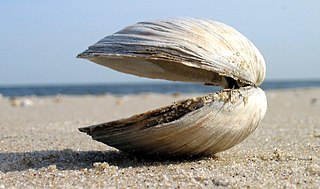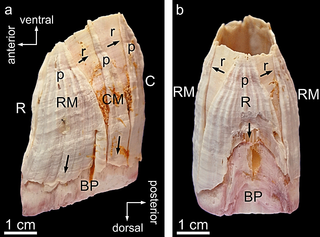
Clam is a common name for several kinds of bivalve molluscs. The word is often applied only to those that are edible and live as infauna, spending most of their lives halfway buried in the sand of the seafloor or riverbeds. Clams have two shells of equal size connected by two adductor muscles and have a powerful burrowing foot. They live in both freshwater and marine environments; in salt water they prefer to burrow down into the mud and the turbidity of the water required varies with species and location; the greatest diversity of these is in North America.

The Pacific razor clam, Siliqua patula, is a species of large marine bivalve mollusc in the family Pharidae.

Ensis is a genus of medium-sized edible saltwater clams, littoral bivalve molluscs in the family Pharidae. Ensis, or razor clams, are known in much of Scotland as spoots, for the spouts of water they eject while burrowing into the sand, when visible at low tide. This term may also colloquially include members of the genus Solen. Ensis magnus are known as bendies due to their slightly curved shell.
Macha is the name of a goddess and several other characters in Irish mythology.

The marine otter is a rare and relatively unknown South American mammal of the weasel family (Mustelidae). The scientific name means "feline otter", and in Spanish, the marine otter is also often referred to as gato marino: "marine cat". The marine otter only lives in saltwater, coastal environments and rarely ventures into freshwater or estuarine habitats. This saltwater exclusivity is unlike most other otter species, except for the almost fully aquatic sea otter of the North Pacific.

The Atlantic jackknife clam, Ensis leei, also known as the bamboo clam, American jackknife clam or razor clam, is a large edible marine bivalve mollusc found on the North American Atlantic coast, from Canada to South Carolina. The species has also been introduced to Europe. The name "razor clam" is also used to refer to different species such as the Pacific razor clam or Razor shell.

Ensis minor, or the jackknife clam, is a long, smooth-shelled, burrowing clam found in the Atlantic Ocean. These clams are often collected for food. Ensis minor can grow up to 17 cm (6.7 in) in length. It is white, sometimes with reddish-brown markings.

Chilean cuisine stems mainly from the combination of traditional Spanish cuisine, Chilean Mapuche culture and local ingredients, with later important influences from other European cuisines, particularly from Germany, the United Kingdom and France. The food tradition and recipes in Chile are notable for the variety of flavours and ingredients, with the country's diverse geography and climate hosting a wide range of agricultural produce, fruits and vegetables. The long coastline and the peoples' relationship with the Pacific Ocean add an immense array of seafood to Chilean cuisine, with the country's waters home to unique species of fish, molluscs, crustaceans and algae, thanks to the oxygen-rich water carried in by the Humboldt Current. Chile is also one of the world's largest producers of wine and many Chilean recipes are enhanced and accompanied by local wines. The confection dulce de leche was invented in Chile and is one of the country's most notable contributions to world cuisine.

The razor shell, Ensis magnus, also called razor clam, razor fish or spoot (colloquially), is a bivalve of the family Pharidae. It is found on sandy beaches in Canada and northern Europe.
The pod razor is a coastal bivalve of European waters. It is edible and has been fished commercially, especially in Portugal, Spain, Ireland and Scotland.

Loxechinus albus is an echinoderm of the family Parechinidae, native to coastal southern South America, ranging from Ecuador, along the entire coasts of Peru and Chile, to Argentina, as well as the Falkland Islands. It is the only species in the genus Loxechinus. It is known as the Chilean sea urchin or red sea urchin, but the latter name is typically used for the North Pacific Mesocentrotus franciscanus and it is not the only species of sea urchin in Chile. L. albus is found on rocky reefs and shores in the intertidal and subtidal zones to a depth of 340 m (1,120 ft).

Austromegabalanus psittacus, the giant barnacle or picoroco as it is known in Spanish, is a species of large barnacle native to the coasts of southern Peru, all of Chile and southern Argentina. It inhabits the littoral and intertidal zones of rocky shores and normally grows up to 30 centimetres (12 in) tall with a mineralized shell composed of calcite. The picoroco barnacle is used in Chilean cuisine and is one of the ingredients in curanto.

Leukoma is a genus of saltwater clams, marine bivalve molluscs in the family Veneridae, the Venus clams. This genus of bivalves has been exploited by humans since prehistory; for example, the Chumash peoples of California harvested this genus from Morro Bay in approximately 1000 AD.

Aulacomya atra, called also the Magellan mussel or the ribbed mussel, is a southern species of edible saltwater mussel, a marine bivalve mollusk in the family Mytilidae, the true mussels. Note that the common name ribbed mussel is also used of the Northern Hemisphere mussel Geukensia demissa.

Pyura chilensis, called piure in Spanish and piür or piwü in Mapudungun, is a tunicate of the family Pyuridae. It was described in 1782 by Juan Ignacio Molina.

Machas la parmesana or “Parmesan machas” is a dish made with the macha. This is a saltwater clam, a bivalve that is native to Peru and Chile, and was used by ancient fishermen. This bivalve is known scientifically as Mesodesma donacium and in English is called either the pink clam, or the surf clam. The dish also includes Parmesan cheese.
Mesodesma is a genus of saltwater clams, marine bivalve mollusks in the family Mesodesmatidae. It is the type genus of the family.

Tetrapygus is a genus of sea urchins in the family Arbaciidae. It is a monotypic genus and the only species is Tetrapygus niger which was first described by the Chilean naturalist Juan Ignacio Molina in 1782. It is found in the southeastern Pacific Ocean on the coasts of South America.













